Page 178 of 267
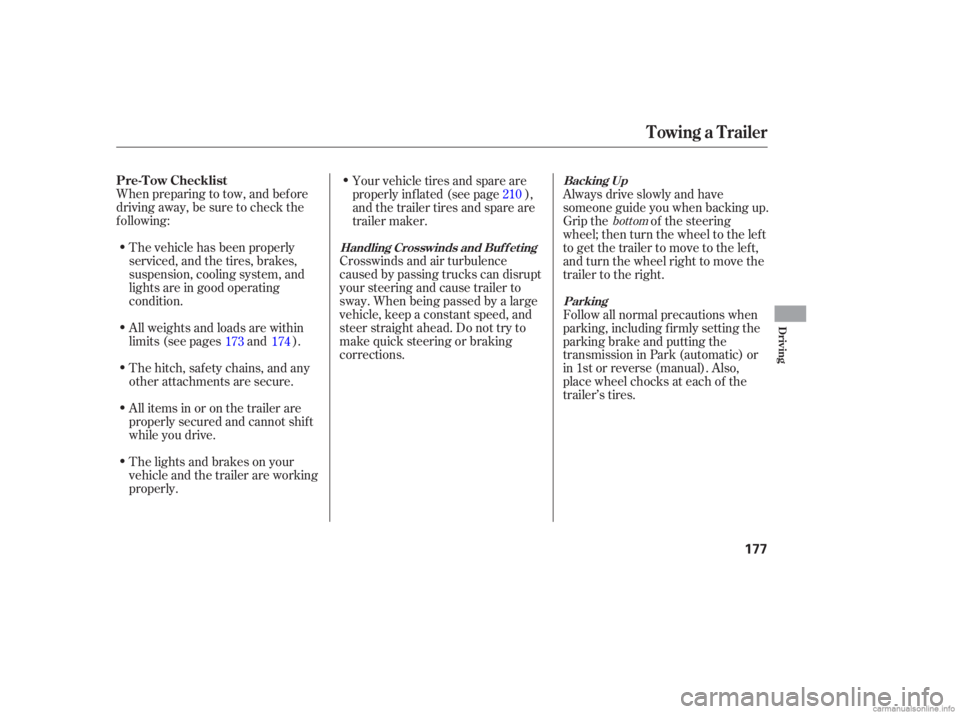
When preparing to tow, and bef ore
driving away, be sure to check the
f ollowing:The vehicle has been properly
serviced, and the tires, brakes,
suspension, cooling system, and
lights are in good operating
condition.
All weights and loads are within
limits (see pages and ).
Thehitch,safetychains,andany
other attachments are secure.
All items in or on the trailer are
properly secured and cannot shif t
while you drive.
The lights and brakes on your
vehicle and the trailer are working
properly. Your vehicle tires and spare are
properly inf lated (see page ),
and the trailer tires and spare are
trailer maker.
Crosswinds and air turbulence
caused by passing trucks can disrupt
your steering and cause trailer to
sway. When being passed by a large
vehicle, keep a constant speed, and
steer straight ahead. Do not try to
make quick steering or braking
corrections. Always drive slowly and have
someone guide you when backing up.
Grip the of the steering
wheel; then turn the wheel to the lef t
to get the trailer to move to the lef t,
andturnthewheelrighttomovethe
trailer to the right.
Follow all normal precautions when
parking, including f irmly setting the
parking brake and putting the
transmission in Park (automatic) or
in 1st or reverse (manual). Also,
place wheel chocks at each of the
trailer’s tires.
173 174 210
bottom
Towing a Trailer
Pre-T ow Checklist
Handling Crosswinds and Buf f et ing
Backing Up
Parking
Driving
177
�����—�����—�����y�
�������������y���
�(�#���������y���
�����y
Page 211 of 267
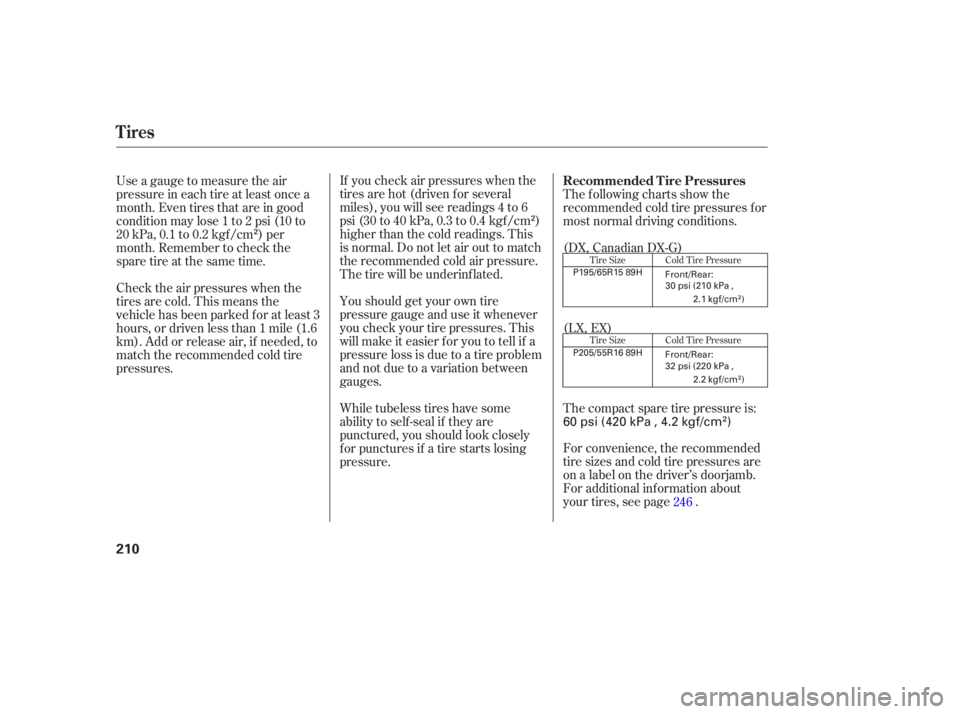
Tire Size
Tire SizeCold Tire Pressure
Cold Tire Pressure
Thecompactsparetirepressureis:
For convenience, the recommended
tire sizes and cold tire pressures are
on a label on the driver’s doorjamb.
For additional inf ormation about
your tires, see page .
If you check air pressures when the
tires are hot (driven f or several
miles), you will see readings 4 to 6
psi (30 to 40 kPa, 0.3 to 0.4 kgf /cm )
higher than the cold readings. This
is normal. Do not let air out to match
the recommended cold air pressure.
The tire will be underinf lated.
Youshouldgetyourowntire
pressure gauge and use it whenever
you check your tire pressures. This
will make it easier f or you to tell if a
pressure loss is due to a tire problem
and not due to a variation between
gauges.
While tubeless tires have some
ability to self -seal if they are
punctured, you should look closely
for punctures if a tire starts losing
pressure.
Use a gauge to measure the air
pressure in each tire at least once a
month. Even tires that are in good
condition may lose 1 to 2 psi (10 to
20 kPa, 0.1 to 0.2 kgf /cm ) per
month. Remember to check the
sparetireatthesametime.
The following charts show the
recommended cold tire pressures f or
most normal driving conditions.
Check the air pressures when the
tires are cold. This means the
vehicle has been parked f or at least 3
hours, or driven less than 1 mile (1.6
km). Add or release air, if needed, to
match the recommended cold tire
pressures. (LX, EX) (DX, Canadian DX-G)
246
Recommended T ire Pressures
Tires
210
60 psi (420 kPa , 4.2 kgf/cm)
P195/65R15 89H
P205/55R16 89H
30 psi (210 kPa ,
2.1 kgf/cm
)
32 psi (220 kPa , 2.2 kgf/cm
)
Front/Rear:
Front/Rear:
�����—�����—�����y�
�������������y���
�(�#���������y�����
���y
Page 218 of 267
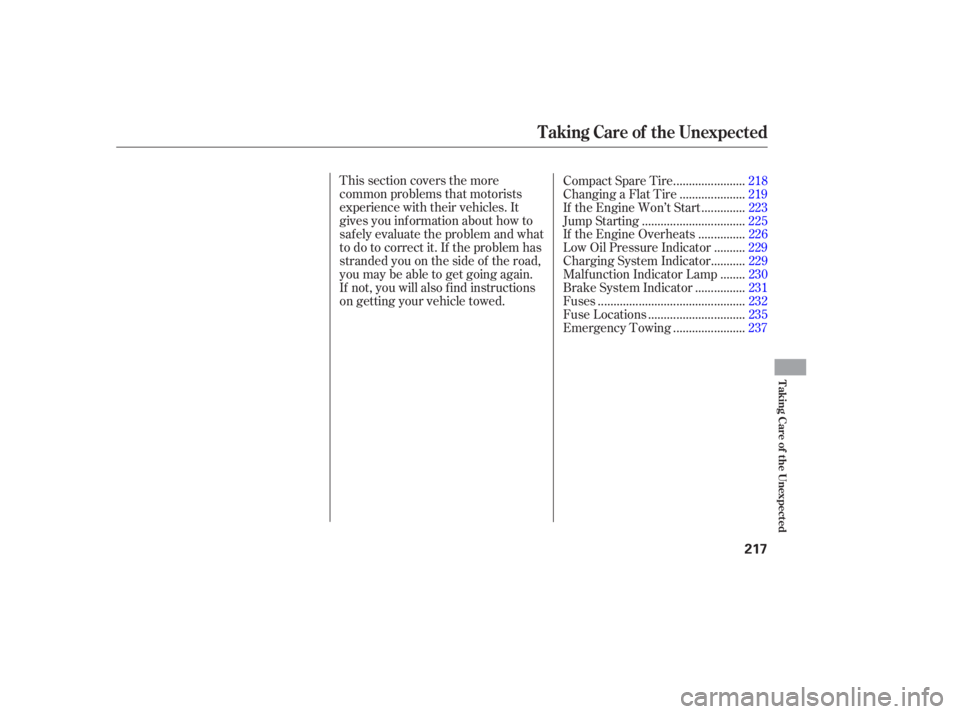
This section covers the more
common problems that motorists
experience with their vehicles. It
gives you inf ormation about how to
safely evaluate the problem and what
to do to correct it. If the problem has
stranded you on the side of the road,
you may be able to get going again.
If not, you will also f ind instructions
on getting your vehicle towed.......................
Compact Spare Tire .218
....................
Changing a Flat Tire .219
.............
If the Engine Won’t Start .223
................................
Jump Starting .225
..............
If the Engine Overheats .226
.........
Low Oil Pressure Indicator .229
..........
Charging System Indicator .229
.......
Malf unction Indicator Lamp .230
...............
Brake System Indicator .231
..............................................
Fuses .232
..............................
Fuse Locations .235
......................
Emergency Towing .237
Taking Care of the Unexpected
T aking Care of t he Unexpect ed
217
�����—�����—�����y�
�������������y���
�(�#���������y���������y
Page 219 of 267

Check the inf lation pressure of the
compact spare tire every time you
check the other tires. It should be
inf lated to:Follow these precautions:
Never exceed 50 mph (80 km/h).
This tire gives a harsher ride and
less traction on some road sur-
f aces. Use greater caution while
driving.
Use the compact spare tire as a
temporary replacement only. Get
your regular tire repaired or replaced,
and put it back on your vehicle as
soon as you can.
Replace the tire when you can see
the tread wear indicator bars. The
replacement should be the same size
and design tire, mounted on the
same wheel. The spare tire is not
designed to be mounted on a regular
wheel, and the spare wheel is not
designed f or mounting a regular tire.
Do not use your compact spare
tire on another vehicle unless it is
thesamemakeandmodel. Do not mount tire chains on the
compact spare tire.
Compact Spare Tire
218
INDICATOR LOCATION MARK
TREAD WEAR INDICATOR BAR
60 psi (420 kPa , 4.2 kgf/cm)
�����—�����—�����y�
�������������y���
�(�#���������y�������
�y
Page 220 of 267
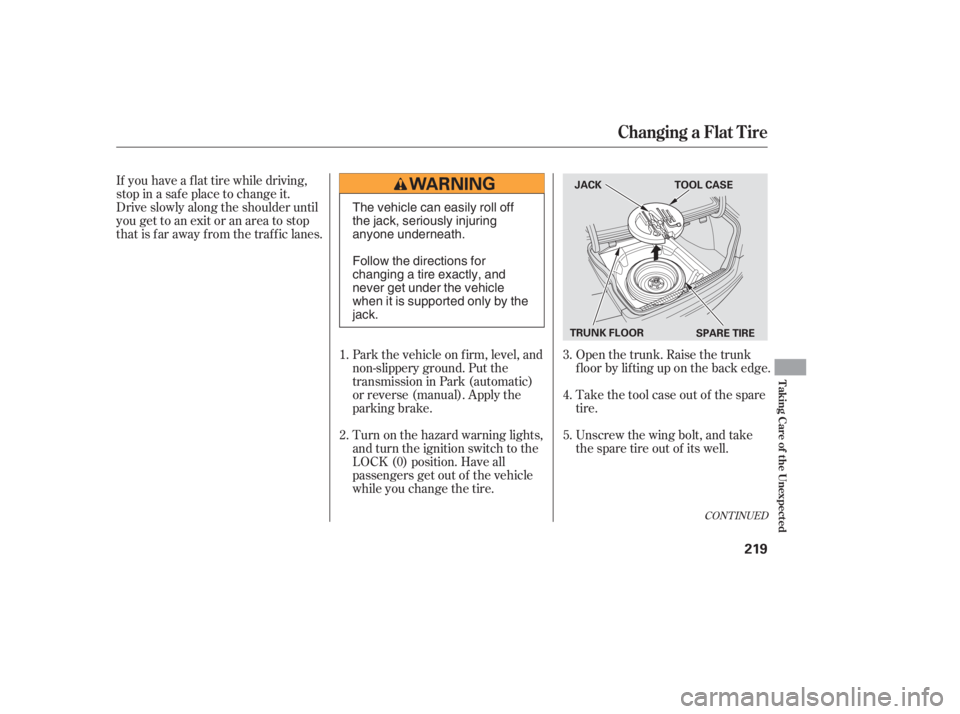
If you have a f lat tire while driving,
stop in a saf e place to change it.
Drive slowly along the shoulder until
you get to an exit or an area to stop
that is far away from the traffic lanes.Turn on the hazard warning lights,
and turn the ignition switch to the
LOCK (0) position. Have all
passengers get out of the vehicle
while you change the tire. Park the vehicle on f irm, level, and
non-slippery ground. Put the
transmission in Park (automatic)
or reverse (manual). Apply the
parking brake.Open the trunk. Raise the trunk
f loor by lif ting up on the back edge.
Take the tool case out of the spare
tire.
Unscrew the wing bolt, and take
the spare tire out of its well.
5. 4.
3.
2. 1.
CONT INUED
Changing a Flat Tire
T aking Care of t he Unexpect ed
219
SPARE TIRE
TRUNK FLOOR JACK
TOOL CASE
The vehicle can easily roll off
the jack, seriously injuring
anyone underneath.
Follow the directions for
changing a tire exactly, and
never get under the vehicle
when it is supported only by the
jack.
�����—�����—�����y�
�������������y���
�(�#���������y���������y
Page 222 of 267
Bef ore mounting the spare tire,
wipeanydirtoff themounting
surface of the wheel and hub with
a clean cloth. Wipe the hub
carefully;itmaybehotfrom
driving.Put on the spare tire. Put the
wheel nuts back on f inger-tight,
then tighten them in a crisscross
pattern with the wheel nut wrench
until the wheel is f irmly against
the hub. Do not try to tighten
them f ully.
Lower the vehicle to the ground,
and remove the jack.
Do not attempt to forcibly pry the
wheel cover of f with a screwdriver or
other tool. The wheel cover cannot
be removed without f irst removing
the wheel nuts. 10. 11.
12.
CONT INUED
DX, LX, and Canadian DX-G models:
Changing a Flat Tire
T aking Care of t he Unexpect ed
221
WHEEL
NUTS
WHEEL NUTS WHEEL COVER BRAKE HUB
�����—�����—�����y�
�������������y���
�(�#���������y���������y
Page 223 of 267
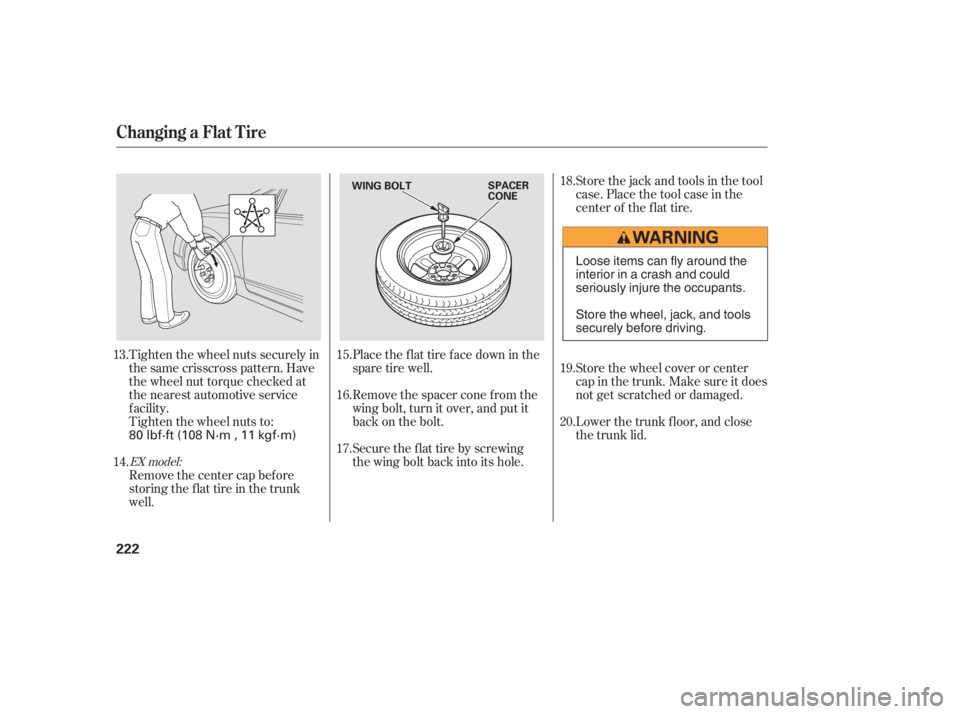
Tighten the wheel nuts securely in
the same crisscross pattern. Have
the wheel nut torque checked at
the nearest automotive service
f acility.
Tighten the wheel nuts to:Place the flat tire face down in the
spare tire well.
Remove the spacer cone f rom the
wing bolt, turn it over, and put it
back on the bolt.
Securetheflattirebyscrewing
the wing bolt back into its hole.
Remove the center cap before
storing the f lat tire in the trunk
well. Store the jack and tools in the tool
case. Place the tool case in the
center of the f lat tire.
Store the wheel cover or center
cap in the trunk. Make sure it does
not get scratched or damaged.
Lower the trunk f loor, and close
the trunk lid.
13.
14. 15.
16.
17.18.
19.
20.
EX model:
Changing a Flat Tire
222
WING BOLT
SPACER
CONE
80 lbf·ft (108 N·m , 11 kgf·m) Loose items can fly around the
interiorinacrashandcould
seriously injure the occupants.
Store the wheel, jack, and tools
securely before driving.
�����—�����—�����y�
�������������y���
�(�#���������y���������y
Page 244 of 267
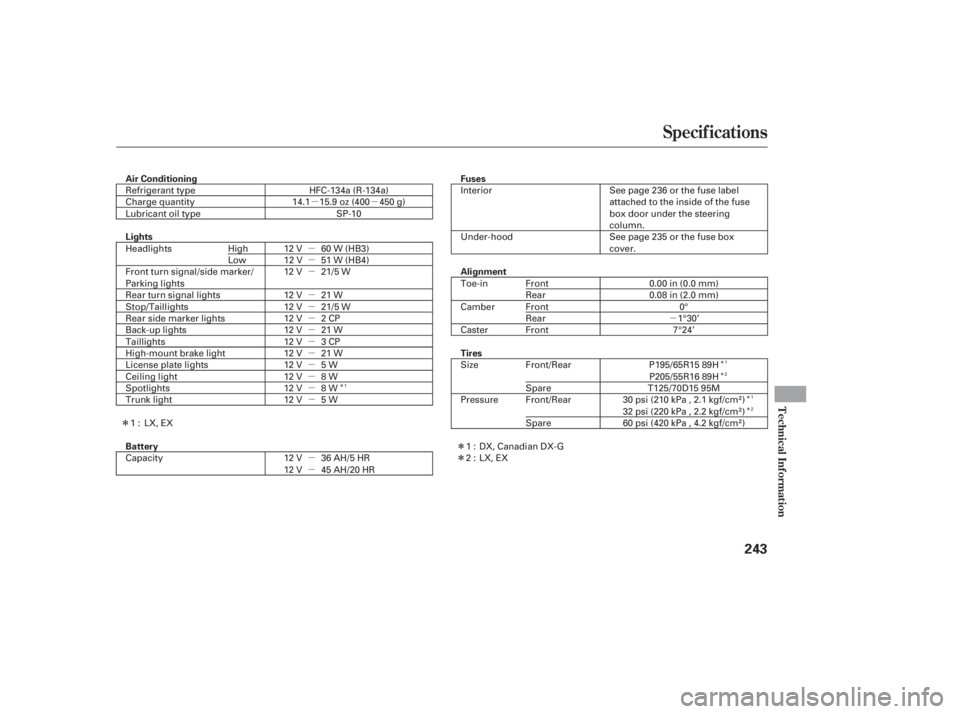
�µ�µ�µ
�µ
�µ
�µ
�µ
�µ
�µ
�µ
�µ
�µ
�µ
�µ
�µ
�µ
�Î �Î
�Î
�µ
�µ
�Î �Î
�Î
�Î
�Î
Specif ications
Technical Inf ormation
243
Air Conditioning Fuses
Alignment
Battery Tires
Lights
HFC-134a (R-134a)
14.1 15.9 oz (400 450 g) SP-10
12 V 60 W (HB3)
7°24’1°30’0°
0.00 in (0.0 mm)
P195/65R15 89H 0.08 in (2.0 mm)
Refrigerant type
Charge quantity
Lubricant oil type
Interior
Under-hood
Toe-in
Camber
Caster
12 V 12 V
12 V
12 V
12 V 12 V 12 V 12 V
8W 5W
21 W
3CP
21 W 21/5 W 21 W 21/5 W
12 V 51 W (HB4)
12 V 2 CP
12 V 8 W
12 V 5 W
Capacity 12 V P205/55R16 89H
Size
Pressure
12 V 45 AH/20 HR 36 AH/5 HR T125/70D15 95M
60 psi (420 kPa , 4.2 kgf/cm
)
32 psi (220 kPa , 2.2 kgf/cm)
30 psi (210 kPa , 2.1 kgf/cm)
See page 236 or the fuse label
attached to the inside of the fuse
box door under the steering
column.
See page 235 or the fuse box
cover.
Headlights
Front turn signal/side marker/
Parking lights
Rear turn signal lights
Stop/Taillights
Rear side marker lights
Back-up lights
Taillights
High-mount brake light
License plate lights
Ceiling light
Spotlights
Trunk light High
Low
Front
Rear
Front
Rear
Front
1: LX,EX 1:
2: LX,EXFront/Rear
Spare
Front/Rear
Spare
DX, Canadian DX-G
1 1
2
1
2
�����—�����—�����y�
�������������y���
�(�#���������y���������y